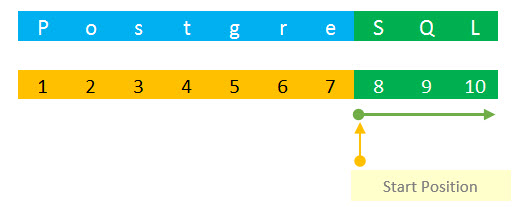Summary: in this tutorial, we will introduce you to PostgreSQL substring function that extracts a substring from a string.
Introduction to PostgreSQL substring function
The substring function returns a part of string. The following illustrates the syntax of the substring function:
1 | SUBSTRING ( string ,start_position , length ) |
Let’s examine each parameter in detail:
- string is a string whose data type is char, varchar, text, etc.
- start_position is an integer that specifies where you want to extract the substring. If
start_positionequals zero, the substring starts at the first character of the string. Thestart_positioncan be only positive. Though in other database systems such as MySQL the substring function can accept a negativestart_position. - length is a positive integer that determines the number of characters that you want to extract from the string beginning at
start_position. If the sum ofstart_positionandlengthis greater than the number of characters in thestring, the substring function returns the whole string beginning atstart_position. The length parameter is optional. If you omit the length parameter, the substring function returns the whole string started atstart_position.
PostgreSQL substring examples
See the following examples:
1 2 3 4 | SELECT SUBSTRING ('PostgreSQL', 1, 8); -- PostgreS SELECT SUBSTRING ('PostgreSQL', 8); -- SQL |
In the first statement, we extract a substring that has length of 8 and it is started at the first character of the PostgreSQL string. we get PostgreS as the result. See the following picture:

In the second statement, we extract a substring started at position 8 and we omit the length parameter. The substring is a string beginning at 8, which is SQL.

PostgreSQL provides another syntax of the substring function as follows:
1 | substring(string from start_position for length); |
In this form, PostgreSQL puts three parameters into one. See the following example:
1 2 3 4 | SELECT SUBSTRING ('PostgreSQL' FROM 1 FOR 8); -- PostgreS SELECT SUBSTRING ('PostgreSQL' FROM 8); -- SQL |
The results are the same as the one in the first example.
In the following example, we query data from the customer table. We select last_name and first_name column. We get the initial name by extracting the first character of the first_name column.
1 2 3 4 5 6 7 | SELECT last_name, SUBSTRING (first_name, 1, 1) AS initial FROM customer ORDER BY last_name; |

Extracting substring matching POSIX regular expression
In addition to the SQL-standard substring function, PostgreSQL allows you to use extract a substring that matches a POSIX regular expression. The following illustrates the syntax of the substring function with POSIX regular expression:
1 | SUBSTRING(string FROM pattern) |
Or you can use the following syntax:
1 | SUBSTRING(string,pattern); |
Note that if no match found, the substring function return a null value. If the pattern contains any parentheses, the substring function returns the text that matches the first parenthesized subexpression.
The following example extracts the house number (maximum 4 digits, from 0 to 9) from a string:
1 2 3 4 5 | SELECT SUBSTRING ( 'The house no. is 9001', '([0-9]{1,4})' ) as house_no |
![]()
Extracting substring matching SQL regular expression
Besides POSIX regular expression pattern, you can use SQL regular expression pattern to extract a substring from a string using following syntax:
1 | SUBSTRING(string FROM pattern FOR escape-character) |
This form of substring function accepts three parameters:
- string is a string that you want to extract the substring.
- escape-character: the escape character.
- pattern is a SQL regular expression pattern. It must be wrapped inside escape characters followed by a double quote ("). For example, if
#is the escape character, the pattern will be#"pattern#". In addition, thepatternmust match the entirestring, otherwise the substring function will fail and return aNULLvalue.
See the following examples:
1 2 3 4 5 6 7 8 9 10 11 | SELECT SUBSTRING ( 'PostgreSQL' FROM '%#"S_L#"%' FOR '#' ); -- SQL SELECT SUBSTRING ( 'foobar' FROM '#"S_Q#"%' FOR '#' ); -- NULLL |
PostgreSQL provides another function named substr that has the same functionality as the substring function.
In this tutorial, we have shown you various forms of the PostgreSQL substring functions that allow you to extract substring based on start position and length, and also based on a regular expression.